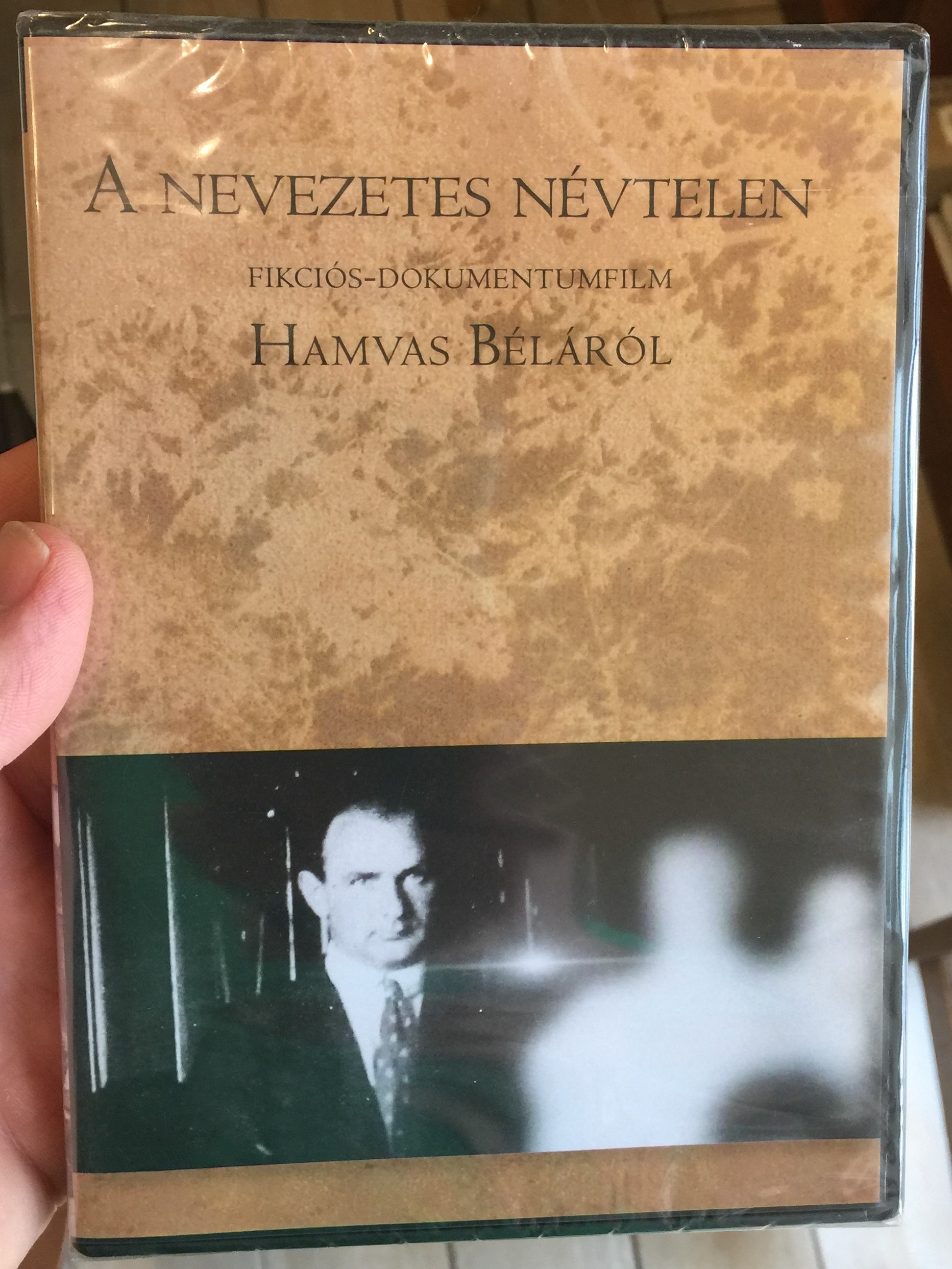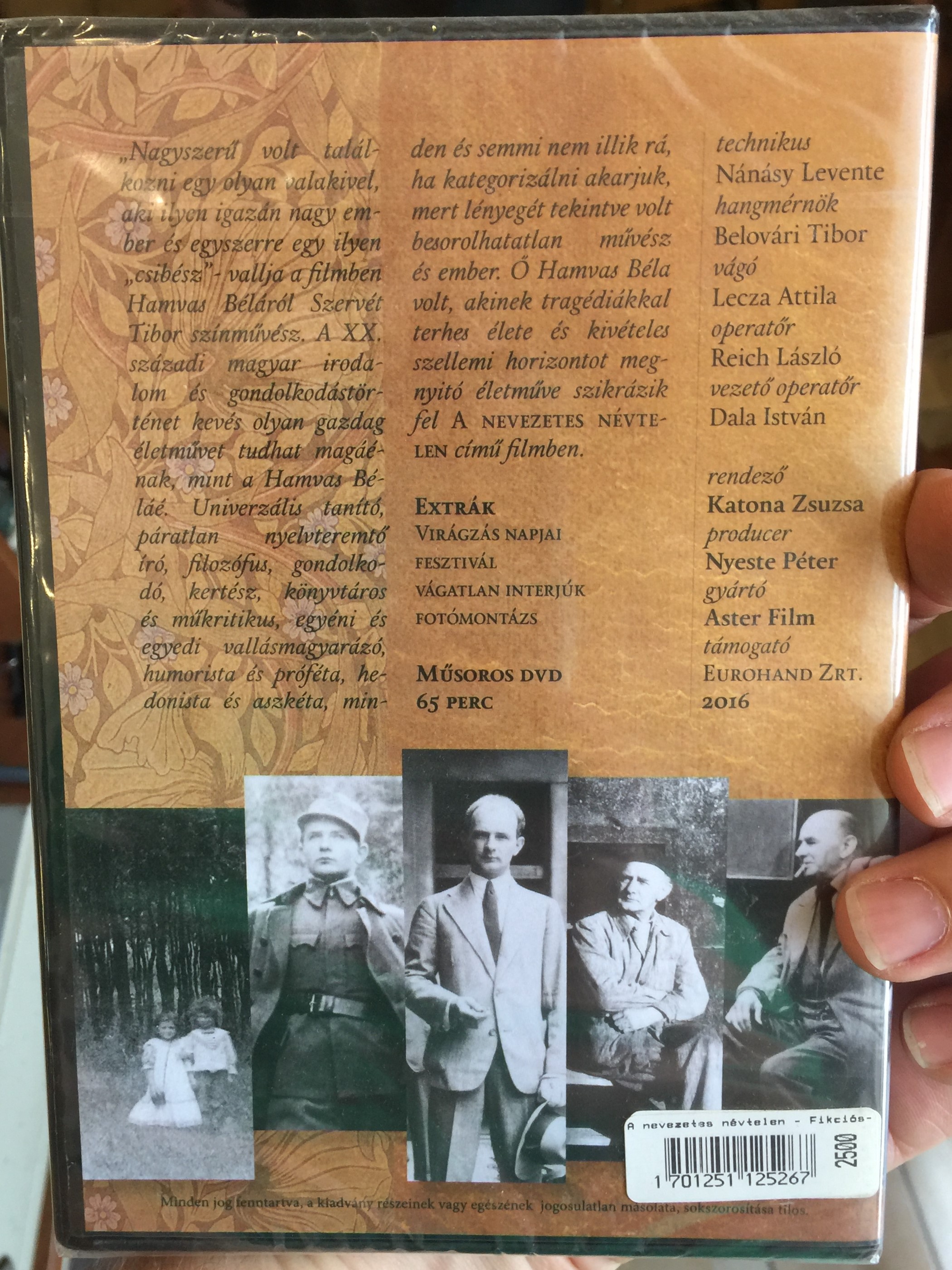Description
A nevezetes névtelen DVD 2016 The notable anonymous - Fikciós dokumentumfilm Hamvas Béláról / Directed by Katona Zsuzsa / Fiction Documentary about Béla Hamvas
UPC 5999010454567 / 1701251125267
REGION 2 PAL DVD
MADE IN HUNGARY
AUDIO: Hungarian 2.0
Total Runtime: 65 minutes
Hungarian Summary:
Nagyszerű volt találkozni egy olyan valakivel, aki ilyen igazán nagy ember és egyszerre egy ilyen "csibész"- vallja a filmben Hamvas Béláról Szervét Tibor színművész. A XX. századi magyar irodalom és gondolkodástörténet kevés olyan gazdag életművet tudhat magáénak, mint a Hamvas Béláé. Univerzális tanító, páratlan nyelvteremtő író, filozófus, gondolkodó, kertész, könyvtáros és műkritikus, egyéni és egyedi vallásmagyarázó, szatírikus vénájú próféta, hedonista és aszkéta, minden és semmi nem illik rá, ha kategorizálni akarjuk, mert lényegét tekintve volt besorolhatatlan művész és ember. Ő Hamvas Béla volt, akinek tragédiákkal terhes élete és kivételes szellemi horizontot megnyitó életműve szikrázik fel A nevezetes névtelen című filmben.
Szereplők / Cast:
Zoltán Rajkai
Ernő Fekete
Erzsébet Kútvölgyi
Tibor Szervét
Péter Rudolf
Zoltán Rátóti
Antal Dúl
Tibor Palkovics
György Spiró
Gábor Szakács
Director
Zsuzsa Katona
Producer
Péter Nyeste
Editor
Attila Lecza
Sound
Tibor Belovári
Costumes
Zsuzsa Balai
He was a great thinker and essayist who integrated Eastern and Western traditions as well as posing many serious questions about the modern age, together with the possibility of resolving them. According to one of his central thoughts: "The present eon, since 600 B.C. stands in the sign of personal salvation. Only since this time is there a notion of humanity, because there is only one single collective category of personality and this is humanity."
Béla Hamvas found his form of expression in the essay, a genre at once literary and philosophical. His early essays were published in Magyar Hüperion (1936, Hungarian Hyperion), marking the end of his first period of thinking, to be followed by Szellem és egzisztencia (1941, Spirit and Existence), an essay discussing the philosophy of Karl Jaspers, one of the main inspirations for Hamvas’ thinking. He published a selection of essays on literature, psychology, philosophy and cultural history in A láthatatlan történet (1943, The Invisible Story). Analyzing the spiritual crisis of the age, Hamvas read himself into the metaphysical tradition, the collective spiritual knowledge of humanity conveyed by sacred books. His collection Scientia Sacra (the first six volumes, 1942–43) served to direct the attention of the age towards the philosophy of the Far East (The Upanishads, Tao Te King, The Tibetan Book of the Dead and others) and European mysticism. From 1945 Hamvas belonged to the spiritual renaissance for three years, during which time he edited the series Leaflets of the University Press, held lectures and published the metaphysical Anthologia humana: Ötezer év bölcsessége (1946, Human Anthology – The Wisdom of Five Millennia), the fourth edition of which was banned and pulped by the socialist regime. His essays written together with his wife on the history of art Forradalom a művészetben: Absztrakció és szürrealizmus Magyarországon (1947, Revolution in Art: Abstraction and Surrealism in Hungary) survey Hungarian art from Károly Ferenczy, Tivadar Csontváry Kosztka and Lajos Gulácsy up to the activity of the “European School”. Hamvas saw in surrealism and abstract art the heritage of magic, the “tremendous presence of a higher existence”, and opposed “realistic” art. This concept of modern art was attacked by the Marxist ideologist, György Lukács, and Hamvas was dismissed from the library and silenced for the rest of his life. His writings were published in samizdat.
























